Lava Viewing at Hawaii Volcanoes National Park
Recently, we hiked out to see the “firehose flow” at Kīlauea Volcano’s Kamokuna ocean lava entry in Hawaiʻi Volcanoes National Park. This post is about our experience hiking out to the viewing area, along with some photos of the lava entering the ocean. I’ll also provide some lava viewing & photography tips, and recommendations for making this hike.
Until the trip, we didn’t know we’d even be making the hike. Lava flow is intermittent at Hawaii Volcanoes National Park, and the viewing area had been closed completely after 26 acres of lava delta and 4 acres of the cliff collapsed on New Year’s Eve. As a result, viewing had closed while the National Park Service evaluated the integrity of the remaining cliff area.
The current lava flow is known as “episode 61g” and is lava flow from the Puʻu ʻŌʻō vent of Kīlauea Volcano. This lava flow is entering the ocean at Kamokuna and is feeding surface flows on and above the pali. It was pretty awesome to see, and quite the memorable experience. If you have the chance, I’d highly recommend going. Just don’t plan the trip too far in advance and consult Hawaii Volcanoes National Park’s “What’s Going On With the Volcano?” status update page (regularly updated), as the lava flow can change…
Currently, there are two options for accessing the firehose lava flow: from the west side via Chain of Craters Road inside Hawaii Volcanoes National Park or from the east side via Kalapana State Wayside Park. From the west side, you park near the Hōlei Sea Arch and hike a little over 5 miles; we were told the last mile of this is really rough terrain (presumably hardened lava). The east side is a longer drive outside of the park, but only a 4.2 mile hike (each way) on a gravel emergency access road.
We had actually been over at Hōlei Sea Arch earlier in the day and could see the steam from Kīlauea Volcano’s lava entering the ocean in the distance, along with a slow trickle of people starting their hike. However, we opted for the shorter, easier hike through Kalapana State Wayside Park. Our rationale was (partly) that it’d be easier, but the primarily motivation was shooting into the sun at sunset, which would not have been possible from the other direction.
I don’t want to say our decision was a mistake, because I stand by it and the epic sunset that night vindicated the decision. I will say this: the ‘scene’ at Kalapana State Wayside Park should be Exhibit A as to why the federal government should preserve our nation’s most sacred lands as National Parks, rather than turning them over to state control.
Kalapana State Wayside Park felt more like a flea market than it did a state park. A cottage industry of various service providers and vendors had a good half-mile of “temporary” tents set up, with no less than a dozen bike rental services, shuttle services, food & beverage, and who knows what else. Parking was being managed by one of the shuttle providers, rather than state park workers. (UPDATE: Based upon comments, it seems this is not a ‘state park’ but a ‘park run by the state.’ Regardless of precise classification, my belief that it’s poorly managed by the state of Hawaii stands.)
Suffice to say, the hike itself wasn’t much better. The shuttles I mentioned above are allowed to exist because there are a few houses on the emergency access road, and those homeowners are driving their “guests” up and down the road. (At least that’s what I’m told, and it’s the only plausible explanation since there was some sort of gatekeeper at the start of the emergency access road.)
Throughout this hike, you thus have to get off the road as the cars and off-road shuttles pass, or else have dirt and gravel slung up at you. Fortunately for most people, almost no one does this as a hike. Just about everyone rents a bike for the journey. I suppose that’d be pretty quick and easy. About the only highlight was that we met someone’s dog and its puppies.
 Being a combination of frugal and someone who enjoys hikes, I wanted to do this as an actual hike–not cheat. So, we hiked. There were only two other people we saw hiking. It was not a fun hike. It was really easy and more a long walk than an actual hike, but it still wasn’t fun.
Being a combination of frugal and someone who enjoys hikes, I wanted to do this as an actual hike–not cheat. So, we hiked. There were only two other people we saw hiking. It was not a fun hike. It was really easy and more a long walk than an actual hike, but it still wasn’t fun.
However, about 3 miles into the hike, you hit the Hawaii Volcanoes National Park entrance. Beyond this point, vehicles are prohibited and you see a lot more people continuing by foot. The hike became about infinity-percent more enjoyable at this point–it became an actual hike. At this point, I’m inclined to rant further about the importance of the National Park Service, but I’ll spare you that.
After maybe another mile of enjoyable hiking, we reached the turn off for the Kamokuna ocean entry viewing area. Here, there was a NPS Ranger with a truck, supply of water, and information for visitors. He advised that we could go to the left to view the ocean entry, or to the right to view surface lava flows.
The hike had taken longer than expected, and I wanted to stake out a spot (there were a ton of people here already) for sunset, so we opted to go left. To the right, I know we could’ve have gotten a few feet from lava on the ground surface, which probably would’ve been a cooler experience…but not as photogenic.
To the left, after maybe a quarter-mile walk over uneven, hardened lava flows, we reached the roped-off viewing area. This was a bit farther inland than I was expecting. From the ocean side of the viewing area, you could vaguely see the lava itself, but not nearly as well as in photos I’ve seen. My guess is that the NPS erred on the side of caution when creating a new viewing area after the collapse, and moved it a bit away from the water.
My recommendation for viewing would be to find a spot along the rope that is closest to the ocean. The photo above was taken as up against the rope on the ocean side, and as you can see, the lava is barely visible around the cliff. The field of view for actually seeing firehose lava flow can be fairly narrow depending upon the flow, so if you don’t get a rope-side spot, you may not see the lava at all.
Closer to the lava is not necessarily better. You’re a half-mile away, give or take, no matter where you stand, so 50 feet one way or the other doesn’t make much of a difference. Instead, find an elevated perch so your view isn’t blocked if someone stands in front of you (and they will).
This is not to diminish the ocean lava entry in any way. It was stunning. From of the most beautiful and captivating scenes I’d ever seen–it just didn’t translate to photos so well.
Fortunately, as the sun started dipping behind the clouds, it was clear mother nature was going to put on a show. This was great news, given that I couldn’t get any direct, close-up photos of the lava flow.
The above photo is a wide field of view that should provide a frame of reference for how far away we were. This was taken right after official sunset time, and was about the sweet spot in terms of the sky’s color. This was the best sunset we had while in Hawaii, and it couldn’t have come at a better time.
In researching lava viewing and photography, I had read a lot about photographers waiting until after the National Park Service Rangers had left the viewing area, and then venturing beyond the viewing area boundaries. My understanding was that this was perfectly safe, and a “wink and a nod” type situation with the National Park Service–so long as they weren’t there and you were careful, they didn’t really care what people did.
And, that very well might have been the case, but after reading about the cliff collapse, I was too spooked to try this. Moreover, it seemed like there were a good number of NPS Rangers (likely because the area had just reopened and due to the past incident), and my guess was that–if their attitude ever was previously lax–they were no longer cool with people going beyond the ropes of the viewing area.
The other problem this would pose is that you’d have to wait until dark to get your photos. Given how bright the lava is, and the way it illuminates the steam as soon as the sun goes down, the peak window for photos is sunset until dusk. You have around a 30 minute window of optimal conditions, before which the sky is too bright for the lava to color the steam, and after which there’s too much dynamic range between shadows and highlights. The above photo was 20 minutes after sunset, and that was probably about 5 minutes after I should’ve taken it. My shots from 5 minutes later are mostly garbage.
Photographing the lava at the Kamokuna ocean lava entry was way more challenging than I expected. I knew what to do in terms of technique, but I didn’t account for the wind off of the ocean, which would pose a challenge for my tripod when mounted with a telephoto lens. (Further photography tips are probably beyond the scope of this report, but I can do a separate post if enough people are interested–just let me know in the comments.)
In the end, I’m fine with the photos I got. They are not the best or most dramatic photos of Kīlauea Volcano’s lava flow, but I think a couple are good as landscape images. They are also nice mementos of our visit to the Kamokuna ocean lava entry.
The hike back was much more pleasant than the hike there. We could see the stars overhead and surface lava flow glowing to the north (inland), and from a distance it looked like the glow of tail-lights on the highway. (It reminded me of hiking up above Yosemite Valley and then looking down at the loop of traffic from a mile up…except with lava.)
Of course, as is always the case on a return hike, it felt considerably longer than the hike out. Instead of being another 4.2 miles, I swear this was like 6 miles. (It wasn’t.) The only explanation for this could be that we had the wind in our faces on the return hike, instead of at our backs, because the hike should’ve been easier once the sun went down.
If I had this to do over again, I would make the hike from the Hōlei Sea Arch side, inside Hawaii Volcanoes National Park. Perhaps I’m just a grumpy curmudgeon, but the roadside kitsch and bike/vehicle traffic of the gravel road “hike” really put a damper on the experience for me. I’d prefer to spin myself as a “purist” rather than a curmudgeon, though.
For me, a hike to see natural beauty is not something to be circumvented; it’s part of the journey that you savor, a precursor that makes the destination itself more rewarding and satisfying. Plus, once you factor in the driving time from inside the park to loop around and go outside to the state park, you’re probably just better off (time-wise) doing a slightly longer hike.
As much as I care about photos, I think hiking in from the Volcanoes National Park side would’ve been the better and more rewarding experience, even if it produced lesser photos (and I’m betting it would have). Alternatively, for the best of both worlds, I’d go at sunrise from the Hawaii Volcanoes National Park side. This would also likely have far, far fewer people, making it a more serene experience, too.
Irrespective of all that, this was a truly incredible experience. Seeing flowing lava firsthand, even from a distance, is amazing; it’s entrancing just watching the lava hit the water, kicking up ash and other debris, as the sparks fly. Even with my grumbling about the hike, if you have the chance to do this, it is absolutely worth the time and effort. A really, really cool experience.
If you’re planning a visit to the Big Island or Oahu, please check out my other posts about Hawaii for ideas of things to do. There are a ton of incredible, under-the-radar experiences in Hawaii, and I highly recommend Hawaii The Big Island Revealed Guide. It’s written by a Hawaii resident, and is far better than other books we’ve read.
Your Thoughts
Have you seen the lava flows in Hawaii Volcanos National Park? If so, how did you do it? Did you go on this hike, or see the flows elsewhere, or via other means? Does the 8+ mile ‘hike’ to see the lava sound worth it to you? Any thoughts or tips of your own to add? Please feel free to ask any questions you might have or share additional thoughts in the comments!


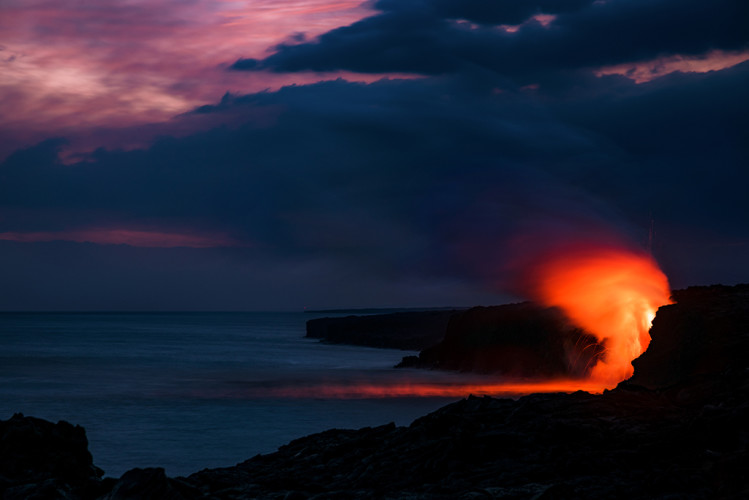
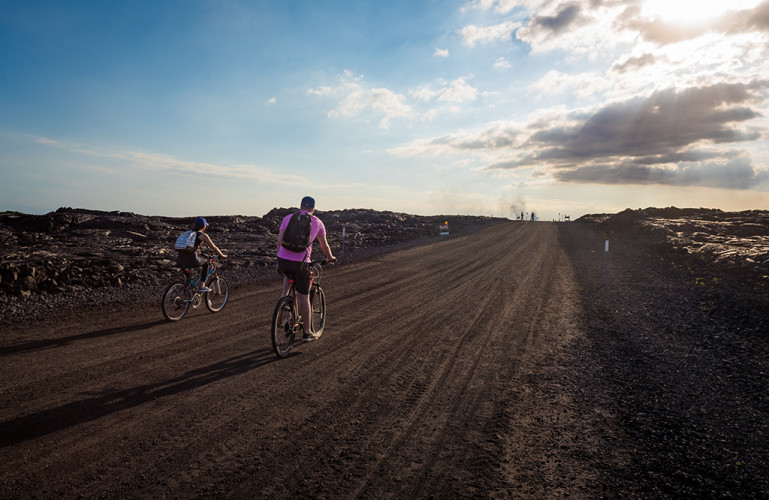


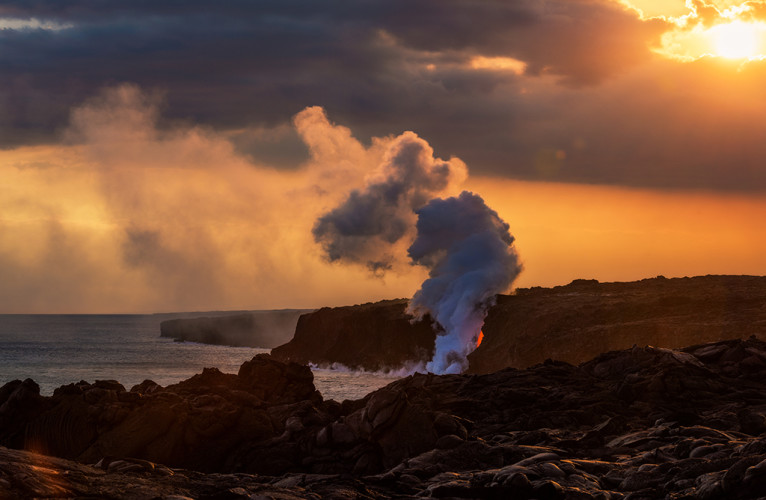



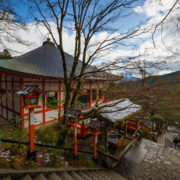


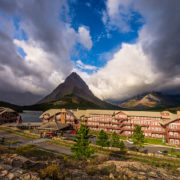




This post was really helpful, I’m hoping to try it out in a couple weeks. How long did the hike take you and when did you get there to be ready for the sunset?
If I recall correctly, the hike took just under two hours. We were there around 45 minutes before sunset, but I’d recommend more time if you want to wander around and see the surface flow.
Aloha , thats not a state park its a county rd where the vendors set up and the Hawaii county rents those spots to the vendors. past the first gate was a emergency access rd that the civil defense manages, u are aload to ride bikes into volcanoes national park
Mahalo! It’s good to know how this area of land is actually managed. Disappointing, regardless, but thanks for the info!
“Kalapana State Wayside Park” “(Is this even a state park, or is it private land and I’m just somehow mistaken? I’d love to be wrong…)”. This place you wrote about is not a State park. The tents, parking, & venders are on State Road managed by the County of Hawaii.
Going to HI Volcanoes NP is on my bucket list. I lived close to an active volcano in Mexico, but I never got close enough to see the actual lava. Wonderful photographs!
The pictures are stunning and always add so much to each of these posts (at your Disney site as well!). Thanks so much for taking the time to include them.
A family trip to Hawaii would be amazing! We’ve been talking and talking about it forever. From Maine to Hawaii… What a great story that would make! We live in Alaska for a while, and never made it down there-one of the biggest regrets ever!
I can’t wait to visit Hawaii! The pictures you took are amazing!
What an awesome post. I would love to visit there one day. The write up and pictures make me feel like I am there.
Sounds like fun!
I took a Big Island circle tour during our Hawaii trip 20 years ago & really enjoyed it. I was a geology major at the time so really enjoyed the stop at Volcanos National Park. Unfortunately it wasn’t actively erupting at that time.
Thank you for sponsoring the giveaway, and for your interesting look into the area!
This would be a dream come true for my husband and I, truly amazing!
I would love for my girls and I to experience Hawaii someday.